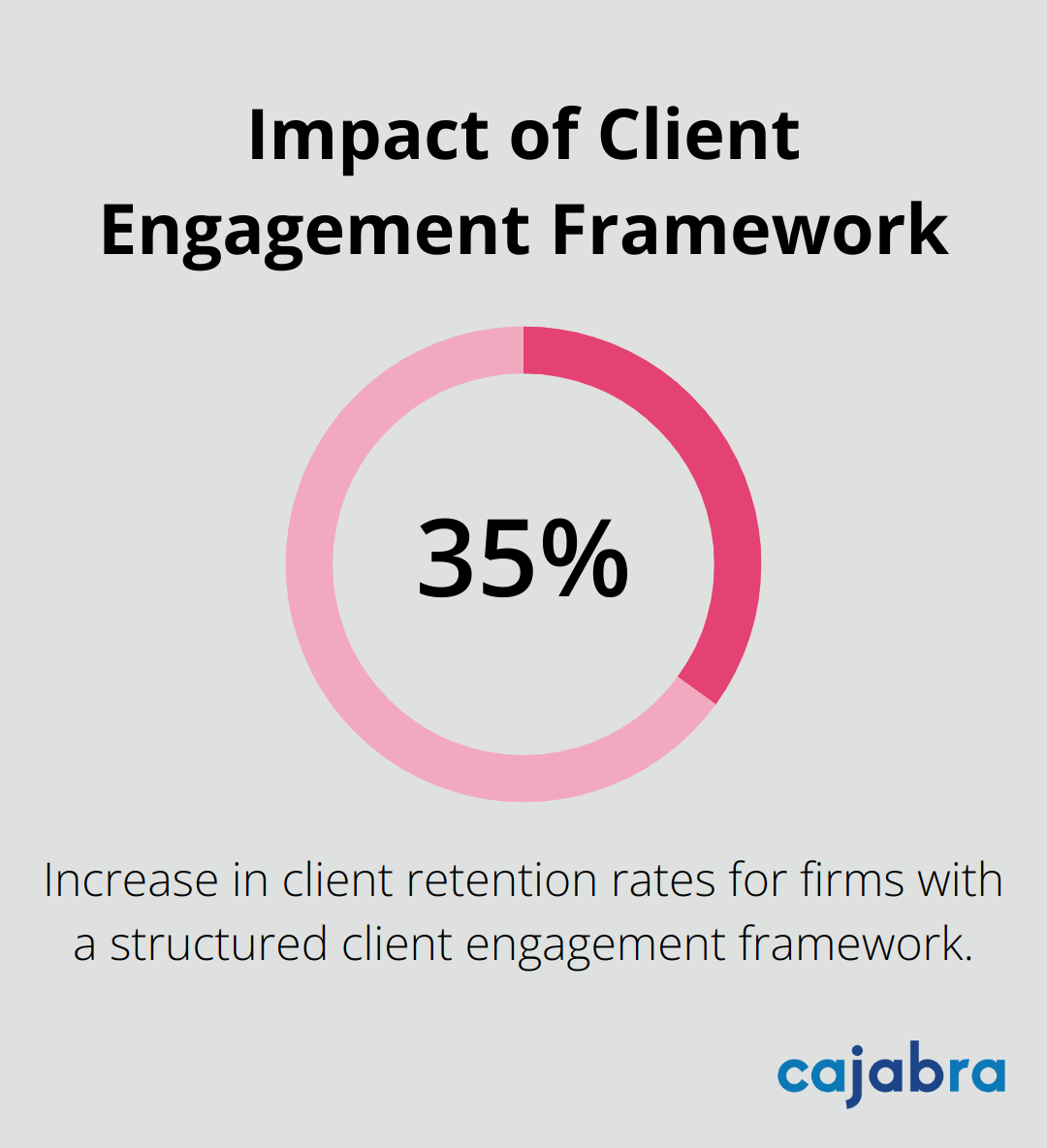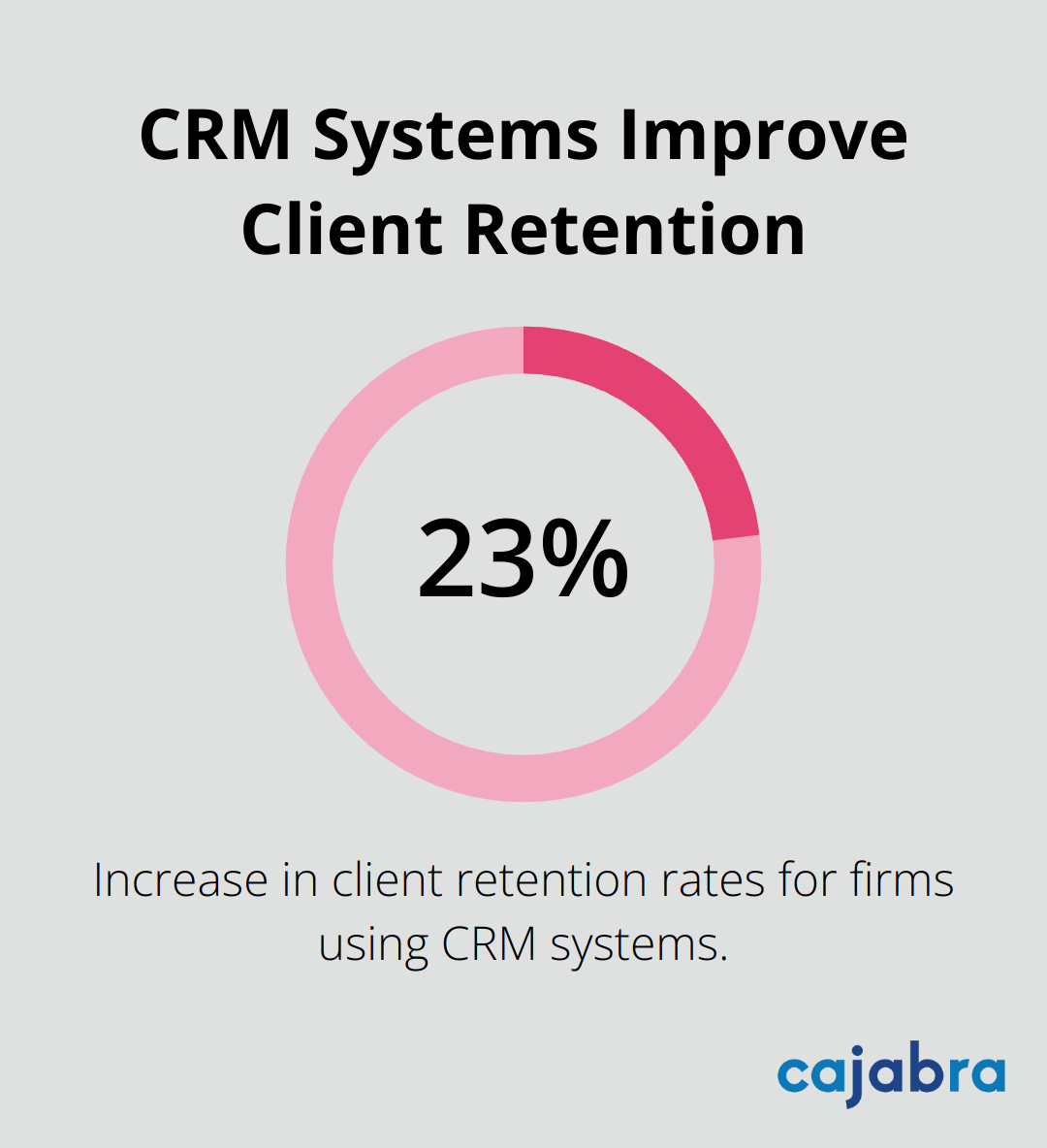
At Cajabra, LLC, we know that strong client relationships are the backbone of any successful accounting firm.
A well-crafted client engagement framework can transform how you interact with your clients, boosting satisfaction and retention rates.
In this post, we'll show you how to build an effective framework that aligns with your firm's goals and meets your clients' needs.
A client engagement framework forms the backbone of successful accounting firms. This structured approach transforms client interactions, creating a consistent and positive experience throughout their journey with your firm.
A robust client engagement framework yields significant advantages. For accounting firms, it results in increased client loyalty, more referrals, and higher revenue per client. A 2025 study showed that brands have a powerful opportunity to implement deeper engagement strategies and stand out from competitors by gathering customer insights.
Clients benefit from more personalized service, better understanding of their financial position, and increased confidence in their accounting partner. This often translates to improved financial decision-making and business performance.
To ensure framework effectiveness, track key performance indicators (KPIs) such as client satisfaction scores, retention rates, and average revenue per client. Use tools like Net Promoter Score (NPS) surveys to gauge client loyalty and identify areas for improvement.
A 2024 study by the American Institute of CPAs found that accounting firms implementing a structured client engagement framework saw a 35% increase in client retention rates. This statistic underscores the critical role that engagement plays in the long-term success of accounting practices.

A client engagement framework requires ongoing refinement based on client feedback and changing market conditions. Continuous evolution of your approach will create lasting relationships that drive mutual success.
As we move forward, let's explore how to develop a client engagement strategy that aligns with your firm's goals and meets your clients' expectations.
Start your strategy by conducting in-depth interviews with your clients. Ask open-ended questions about their business goals, pain points, and expectations from your services. A 2024 survey by the American Institute of CPAs revealed that firms who regularly conducted client needs assessments experienced a 28% increase in client satisfaction scores.

Use tools like SurveyMonkey or Typeform to create quick, targeted surveys that gather insights on client preferences and priorities. Analyze the results to identify patterns and tailor your services accordingly.
Client communication requires a tailored approach. Develop a matrix that matches client preferences with communication channels. For example, tech-savvy clients might prefer video calls and instant messaging, while traditional businesses may value face-to-face meetings.
Implement a CRM system (like Salesforce or HubSpot) to track client interactions and preferences. This allows you to personalize each touchpoint, from email campaigns to product recommendations.
Work with clients to establish specific, measurable goals for your engagement. Use the SMART framework (Specific, Measurable, Achievable, Relevant, Time-bound) to define objectives. For instance, "Reduce tax liability by 15% within the next fiscal year" provides a clear, actionable goal.
Create a shared dashboard using tools like Trello or Asana to track progress towards these goals. This transparency builds trust and keeps both parties accountable.
Establish a system for regular feedback. This can include quarterly surveys, annual reviews, or informal check-ins after major projects. Use this feedback to refine your services and address any concerns promptly.
Consider implementing a Net Promoter Score (NPS) system to gauge client satisfaction and loyalty over time. This metric can provide valuable insights into the effectiveness of your engagement strategy.
Utilize technology to streamline your engagement process. AI-powered analytics tools can help you identify trends in client behavior and preferences. Secure document sharing platforms (such as Dropbox Business or Google Workspace) facilitate smooth collaboration and information exchange.
The next step in creating an effective client engagement framework involves selecting and implementing the right tools and technologies to support your strategy. Let's explore how these can enhance your client relationships and streamline your processes.
Customer Relationship Management (CRM) systems form the cornerstone of modern accounting firms. These systems centralize client data, track interactions, and provide valuable insights. Salesforce and HubSpot are popular choices, but industry-specific CRMs like Karbon or Canopy offer tailored features for accountants.
A 2024 study by Accounting Today revealed that firms using CRMs experienced a 23% increase in client retention rates. These systems enable you to set reminders for follow-ups, track client preferences, and personalize communications at scale.

Effective client engagement often depends on smooth project execution. Platforms like Asana, Trello, or ClickUp help you manage deadlines, assign tasks, and keep clients informed. These tools promote transparency and accountability, which build trust.
Firms that use project management software report a 30% reduction in missed deadlines and a 25% increase in client satisfaction scores. The key is to select a platform that integrates well with your existing tech stack and offers client-facing features.
Artificial Intelligence revolutionizes how we understand and predict client behavior. Tools like IBM Watson Analytics or Google's BigQuery ML analyze vast amounts of data to identify patterns and trends. This allows you to anticipate client needs and tailor your services proactively.
For example, AI-enabled customer service can increase customer engagement, resulting in increased cross-sell and upsell opportunities while reducing costs. This approach allows you to reach out at the right moment with relevant services.
In the accounting world, data security is paramount. Platforms like ShareFile, SmartVault, or Citrix ShareFile provide bank-level encryption for document sharing and storage. These tools protect sensitive information and streamline the document exchange process.
A secure document sharing solution can reduce email back-and-forth by up to 60% and significantly decrease the risk of data breaches. This efficiency and security boost can become a major selling point for potential clients.
The strategic implementation of these technologies creates a robust client engagement framework that sets your firm apart. The goal is not just to adopt new tools, but to integrate them seamlessly into your client engagement strategy for optimal results.
A client engagement framework transforms how accounting firms interact with their clients. It creates lasting relationships through clear communication, personalized service, and proactive problem-solving. Firms that prioritize engagement experience increased client loyalty, more referrals, and higher revenue per client.
Implementing a client engagement framework requires a commitment to understanding client needs and leveraging technology. CRM systems, project management platforms, and AI-powered analytics (among others) streamline processes and provide valuable insights. These tools allow firms to anticipate and meet client needs proactively.
We at Cajabra understand the challenges accounting firms face in today's competitive landscape. Our specialized marketing services help firms stand out and attract retainer-based clients. A robust client engagement framework, combined with our expertise, positions accounting firms as trusted advisors and industry leaders.



